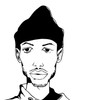Geoffrey Farmer, Boneyard, 2013 (detail) Paper, wood, and glue Dimensions variable, Installation view, Cut nothing, cut parts, cut the whole, cut the order of time, Casey Kaplan, New York, 2014 Photo: Jean Vong Courtesy the artist and Casey Kaplan, New York © 2016 Geoffrey Farmer
Geoffrey Farmer, The Surgeon and the Photographer, 2009-ongoing. Paper, textile, wood, and metal, Dimensions variable, Vancouver Art Gallery. Purchased with funds from the Jean MacMillan Southam Major Art Purchase Fund, Phil Lind, Vancouver Art Gallery Acquisition Fund, Canada Council for the Arts Acquisition Assistance Program, and the Michael O'Brian Family Foundation. Installation view, The Curve, The Barbican Art Centre, London, 2013 Photographs: Alessandro Quisi, Courtesy the artist and The Barbican Centre, London © 2016 Geoffrey Farmer
when all the lights burn low
who seek to learn what men would hide in desks
and deny us the right to knowPushing brooms and mops and wielding lights
of brush aluminum and steel
we talk the darkened corridors
in guard of all that’s realFor otherworldly danger lurks
in shadows grown long across the floor
from flick’ring candles, lowered lamps
or moonlight shining round the door
monsters, villains, miscreants young and old
who would seek to invade our halls
‘tis our noble duty to them deter
or else find them, and kick them in the balls”
Geoffrey Farmer, Universal Sculpture Series, 2, 2013, Paper, glue, and putty 8 1/2 x 6 x 7 3/4 inches (21.6 x 15.2 x 19.7 cm) Photo: Jean Vong. Courtesy the artist and Casey Kaplan, New York © 2016 Geoffrey Farmer
Geoffrey Farmer, Universal Sculpture Series, 1, 2013 Paper, glue, and putty 8 1/2 x 5 7/8 x 7 3/4 inches (21.6 x 14.9 x 19.7 cm) Photo: Jean Vong. Courtesy the artist and Casey Kaplan, New York © 2016 Geoffrey Farmer
